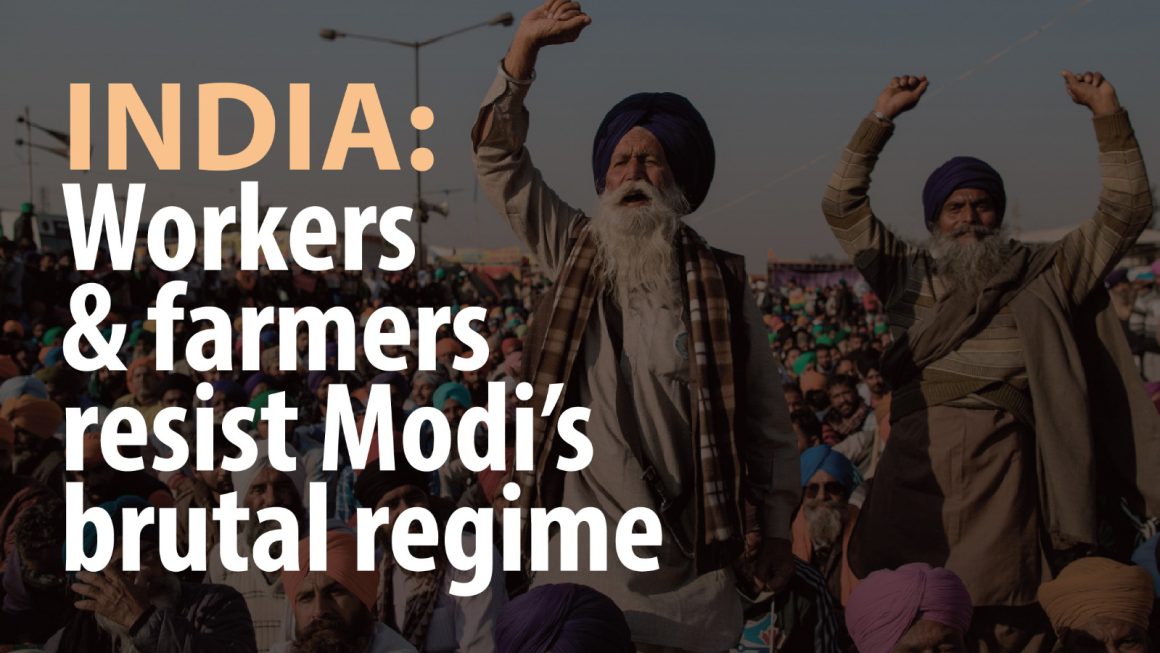India saw the world’s largest-ever general strike in 2020 with hundreds of millions of workers and trade unionists supporting farmers in their struggle against the right-wing policies of the Modi government. Martina Stafford reports on this mass movement.
India’s capitalist government is led by the reactionary Hindu fundamentalist Bharatiya Janata Party (BJP), headed by Prime Minister Narendra Modi. In September 2020, the Modi Government passed three laws that would dismantle the very few protections and regulations in place to provide some degree of security for small farmers. One of the new laws would, in reality, repeal the minimum support price (MSP), a minimum price set for crops like rice, cotton, and wheat, at which the government promises to buy produce from small farmers as basic protection. As well as the fact that the provisions of these laws are highly skewed in favour of private capital already, with no limits on stockholding and restrictions of government interventions, there is also limited recourse available through any independent grievance mechanism.
Soon after the farm bills were passed by parliament, farmer unions began holding local protests mostly in the state of Punjab. After two months of protests, some farmer unions began a movement called ‘Dilhi Chalo’, meaning: ‘Let’s go to Delhi’. This initiative led to tens of thousands of farmer union members marching toward the nation’s capital, Delhi, on 25 November. The Indian government, however, ordered law enforcement to prevent the protesters from entering Delhi by means of water canons, batons and tear gas.
On 26 November, a nationwide general strike of 250 million workers took place in support of the farmers and to fight against proposed changes to labour laws, with some states witnessing a complete shutdown. The unions alleged that BJP members, with the “tacit support” of the party-led government in Tripura, tried unsuccessfully to open shops. Failing that they attacked and ransacked the offices of the trade unions and the Left parties which supported the strike. Numerous trade union leaders and activists were arrested in several different states, illustrating the authoritarian nature of the Modi regime and the Indian state generally
No future for small farmers
In a population of 1.4 billion, those employed in agriculture make up over half of the labour force. In the 1960s, the ‘Green Revolution’ brought US advisors into India to modernise farming to help boost the production of rice and wheat. This led to an overuse of chemical fertilisers, pesticides, and irrigation which caused large plots of land to become infertile. Many crops suffered, some nearly disappeared, but rice and wheat production soared which quickly led to a food surplus that continues to this day.
Of course, this “surplus” is not surplus to the needs of the 189.1 million people who are undernourished in India1. As of July 2020, there were over 91 million metric tons of food grain surplus lying with the government, very little of which was distributed for free.2 Social scientist Jeff Dreze poignantly points out that if these sacks were lined up in a row, they would reach to the moon three times over.3
In India and many other neo-colonial countries, the International Monetary Fund (IMF) intervenes to assist big agribusiness in monopolising the agricultural market so that companies can then control supply and demand, and manipulate prices to their own advantage at the expense of small farmers. Small and marginal farmers have shifted to cash crops over the past three to four decades, pushed by promises that hard currency would mean liberation from poverty. However, if farmers are growing a cash crop like vanilla which has no local market and which is meant for export, the corporation can drop their price and the farmer has no real way of challenging this action. During the lockdown in April 2020, crops were either lying unsold or, if perishable, died in the fields. With so much land dedicated to the precariousness of cash crop economics, and the erratic weather patterns looming due to climate change, this points to an alarming degree of mass vulnerability and insecurity.
India has witnessed an epidemic of suicide among farmers with an estimated 315,000 farmers have taken their own lives between 1995 and 2018. Researchers report that smaller farmers who cultivate capital-intensive cash crops, which are subject to price fluctuations, are most likely to have debts that they are unable to pay back, and are therefore at greater risk of committing suicide. Some observers have suggested that the introduction of genetically modified varieties of crops since “liberalisation” has considerably worsened the situation: the cultivation of such crops is “ecologically vulnerable since it is based on monoculture of introduced varieties and on non-sustainable practices of chemically intensive farming”. The fundamental point of agriculture should be to take care of the basic needs of the population first and foremost and furthermore to ensure sustainable and robust methods are employed with the utilisation of the best science. Farmers need to be supported to do this, not punished if they don’t live up to the tasks of the utter madness of capitalist economics.
Capitalist inequality exposed
The Covid-19 pandemic has brutally exposed the contradictions of capitalism in India. Tens of millions of migrants attempting to return to their villages from the cities and towns after the prime minister gave the population of a state of just under 1.4 billion four hours notice to total lockdown! With public transport shut down, some walked over a thousand kilometres to reach their villages whereupon many were arrested for violating the lockdown, after being apprehended at inter-state borders. Sixteen migrants were killed after a freight train ran over them while they were sleeping on the tracks, exhausted from walking. In a country where over 80% of the workforce is informal, the lockdown drove hundreds of millions into joblessness and hunger overnight.
India has only around one hospital bed for every 2,000 people,4 one of the lowest ratios in the world, and one doctor for every 10,000 patients – ten times less than the numbers recommended by the WHO. However, India ranks third worldwide for pharmaceutical production by volume and 14th by value.5 Yet 38 million people in the country were pushed below the poverty line in a single year (2011-2012) solely due to spending on medicines.6 Of India’s more than 2.3 million annual deaths among children, about 334,000 are attributable to diarrhoeal diseases.7 There is absolutely no reason why every single person in India couldn’t have access to sufficient nutrition and quality healthcare. With huge wealth and a food surplus to reach to the moon, the barriers are clearly not the lack of wealth or resources.
Instead of using the existing wealth in the interest of the majority of the people, policies since the early 1990s have instead been aimed at strengthening private profit. In the early ‘90s, India started liberalising its economy in all major sectors. One aspect of this was the establishment of Special Economic Zones (SEZs), which allowed multinational investors to avoid export tariffs and bypass labour regulations. This created a new layer of contract workers with very few rights. The workforce is sometimes 70-80% contract workers, versus a small percentage of permanent workers. Contract workers are often migrants without local roots or connections, who have less legal protection and rights, and are paid far less than permanent workers. The bosses have a ready supply of migrant labour to take the place of other workers, which strengthens the ability of bosses to break strikes or at the least to sow division between permanent and temporary labour.
Nevertheless, there are many examples of workers overcoming these kinds of divisions in struggle. Labour researcher, Immanuel Ness, describes the example of the struggle of Maruti Suzuki autoworkers in New Delhi’s industrial belt.8 After rounds of firings and the replacement of permanent workers with contract workers, the former concluded that in order to win their struggle for union recognition they would need to unite with the contract workers. Their demands included “employer recognition of their union, elimination of tiered wages and reclassification of informal workers as permanent employees.” The permanent workers refused to accept a deal that did not apply equally to all workers, and the contract workers fought alongside permanent workers in their struggle for union recognition. In the course of this struggle, the workers discovered that they were not just fighting their employer. In fact, their employer also had the backing of the state, the media, and even the union leadership. Sometimes this backing was passive, such as turning a blind eye to the use of hired company thugs. At other times, the state intervened directly on behalf of the capitalist class, using police or military force to brutally put down the workers.
Protests challenge BJP rule
The government has engaged in 11 rounds of talks with farmers and offered to hold off implementing the reforms for 18 months, but the farmers insist they must be withdrawn. In early February, the government erected metal barricades, cement walls, iron spikes, and barbed fences at the roads leading to the three main borders to block protesters from entering Delhi by vehicle or on foot.9 On the other side of these fences, large protest sites organised by farmers’ organisations have developed, with makeshift kitchens deployed to meet the food needs of the thousands of farmers. Along with these kitchens, a makeshift school has been set up at the camp, mostly for children who are unable to attend school due to financial issues and the ongoing pandemic.
At the Singhu border, farmers have installed eight CCTV cameras to keep a watch on the protest site and combat government attempts to smear the farmers as violent or anti-social. The Union Minister for Food, Railway and Consumer Affairs, Piyush Goyal, has described the protesting farmers as “Leftist and Maoist”, stating they have been “hijacked” by unknown conspirators.10 BJP MLA Surendra Singh said, “this is a sponsored agitation by anti-national forces and has foreign funding”.
The farmers are right to be concerned about sinister divisive counter-narratives being posed by the media which is owned by large corporations whose interest – aligning with the BJP – is certainly in squashing the movement. The BJP and the capitalist class regularly use religious, caste and other divisions to help maintain their rule. In these protests, we have seen the potential for unity across these lines. Dalit labour rights activists Nodeep Kaur and Shiv Kumar – who had been mobilising support for the ongoing farmers’ agitation by highlighting the need for farmer-worker unity – were arrested and tortured while in custody. In the Varna system of Hinduism, Dalit people are considered to belong to the lowest Varna (or caste) which generally manifests as extreme poverty, segregation and discrimination for Dalit people. Nodeep Kaur organised 2,000 labourers in December where she was working in a factory and marched to the Singhu border. Here are her words:
“This not just a farmer’s struggle, but the struggle of labourers and students as well, until we come together, neither the farmer is going to be successful nor anybody else, we will close down all their factories and get the labourers to join the farmers.”11
Overcoming division through struggle
The recent citizenship amendments, which exclude Muslims from four neighbouring countries from gaining citizenship, demonstrates what the BJP are all about: sowing division. This discrimination is not limited to Muslims. Sri Lankan Tamils, who are predominantly Hindu, are also excluded from gaining citizenship. Western Uttar Pradesh’s sizeable Muslim population, whose opposition to the Modi government’s citizenship laws in 2019 was quietened by heavy-handed policing, has now allied with Hindu farm leaders to join the ongoing protests.
The policies of communal division are meeting the mass opposition of hundreds of thousands, with young people and women at the forefront. An inspiring protest led by women began in December 2019 in Shaheen Bagh in Delhi, where hundreds of women blocked a main road and began a sit-in demonstration that lasted for 101 days.12 Protesters agitated against the new divisive citizenship laws but also against police brutality, unemployment, poverty and women’s safety. The protesters also supported labour unions by opposing the government’s anti-labour policies. Similar female-led sit-ins cropped up across the country, including in Kolkata’s Circus Maidan park. Shafqat Rahim, a 25-year-old law student from a conservative Muslim family said, “The protests are shaping up like a revolution where women have taken the leading roles”.
On International Women’s Day, more than 20,000 women farmers joined protest sites just outside Delhi, highlighting their rightful place at the forefront of the struggle.13 As the protests continue, the need to look beyond Delhi and to organise nationally has become increasingly apparent. The movement must strategize to avoid being isolated and less vulnerable to divisive attacks by the government and its allies. There have been local protests outside Delhi in several northern states, including Punjab, Uttar Pradesh, Haryana, Rajastan and others, but these need to be stepped up and spread to the south as well. This is not necessarily an easy task but for the movement to be successful, it needs mass mobilisations in the vast majority of the country. Furthermore, the farmers need the support of the workers, and the workers need the farmers to win, or they will face an emboldened BJP intent on privatising railways, banks, ports, insurance companies, and more. Joint action committees of farmers, workers, and young people could help to strengthen the spine of the movement, facilitating democratic discussion and organisation.
Where Now for the Movement?
Modi and the BJP have no qualms with provocations and violence, and they can get away with it if no political alternative is built. The supposed main opposition to the BJP – The Indian National Congress – overwhelmingly supports the same policies as the BJP. The Communist parties retain a significant base. However, they have been seeking alliances with the discredited Congress party. A working-class party that broke with this approach and offered a clear and independent socialist alternative for workers and farmers could now attract mass support.
This could include a programme for small farmers: rejecting cash crop economics and instead advocating agriculture for the benefit of people, with collaboration between farmers, facilitated by the nationalisation of the banking system under the democratic control by workers, farmers, and users to provide credit. It could unite farmers and workers – rejecting sexism, communal division, and caste prejudices to pose the idea of fighting for socialist change; to wrest political and economic power from the wealthy minority and for a democratically planned economy where inequality and oppression are abolished and the needs of the masses are fully met.
Notes
- www.indiafoodbanking.org/hunger
- P. Sainath, 14 Aug 2021, ‘We didn’t bleed him enough’, Frontline, www.frontline.thehindu.com
- Jean Drèze, 29 Mar 2019, ‘Food subsidies do not keep the poor from starving’, www.scroll.in
- Kennedy & King, 2014, Globalization and Health, http://www.globalizationandhealth.com
- India Brand Equity Foundation, 28 Feb 2021, ‘Indian Pharmaceuticals Industry Report’, www.ibef.org
- Newsclick Report, 13 Jun 2018, ‘38 Million Indians Impoverished Because Of Buying Medicines In A Single Year, Says Study’, www.newsclick.in
- Bulletin of the World Health Organization, ‘Rotavirus mortality in India: estimates based on a nationally representative survey of diarrhoeal deaths’, www.who.int
- Immanuel Ness, 2016, Southern Insurgency: The Coming of the Global Working Class, Pluto Press
- Aljazeera, 3 Feb 2021, ‘Iron spikes, concrete walls at India farmer protest sites’, www.aljazeera.com
- Amil Bhatnagar, 27 Dec 2020, ‘Month on, as protest grows, farmers install CCTVs to keep eye on crowd’, The Indian Express, www.indianexpress.com
- Pawanjot Kaur, 3 Feb 2021, ‘Nodeep Kaur, Who Fought for Workers’ Rights, Faced Custodial Torture, Alleges Family’, www.thewire.in
- Express Web Desk, 24 Mar 2020, ‘Shaheen Bagh’s 101-day protest: Timeline of sit-in against CAA’, The Indian Express, www.indianexpress.com
- Hannah Ellis-Petersen & Shaikh Azizur Rahman, 21 Jan 2020, ‘Modi is afraid’: women take lead in India’s citizenship protests’, The Guardian, www.theguardian.com












